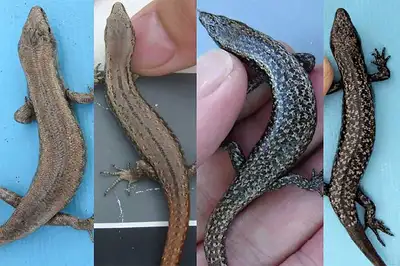
Dr Marleen Baling graduates in Auckland.
Dr Marleen Baling has shown to be just as adaptable as the skinks she has been studying in pursuit of her doctorate degree.
Graduating last week at Massey’s graduation ceremony in Takapuna, Dr Baling has delved further into our understanding of the shore skink, Oligosoma smithi.
These skinks have the greatest variation in body colouration of all our native lizards and can be found with pale colours through to very dark colours and can also have highly patterned colouration.
When Dr Baling was a research technician within the ecology group at the University’s Albany campus between 2005-09, she saw this dramatic colouration in shore skink populations at various mainland sites and offshore islands in Hauraki Gulf and Whangarei. So, as part of her PhD thesis in 2012, she decided to find out why that was under supervisors Professor James Dale, Professor Dianne Brunton and Associate Professor Devi Stuart-Fox.
In general, animal colouration can serve several biological functions, a key one being camouflage. Dr Baling investigated factors that can affect camouflage colouration in this New Zealand native skink, and if it conflicts with conspicuous colouration for social interaction (e.g., breeding) or thermoregulation.
She found that degree of camouflage colouration was influenced by microhabitat and predator search image, and that colouration for social signalling did not affect camouflage within a population. However, the influence of thermoregulation on colour was stronger among populations. Dr Baling’s thesis provided new insights on how different selection processes maintain dramatic colouration within a species, and marks the first quantitative research on colouration in New Zealand reptiles.

The four dorsal body pattern types assigned to shore skinks at Tāwharanui Regional Park.
Tāwharanui Regional Park
She conducted her research at Tāwharanui Regional Park to collect information on colouration trends within a wild population of shore skinks, at Tiritiri Matangi Island to assess any change in colouration in a translocated population as a response to a change in habitat, and a multi-population survey to determine colour variation between different locations.
During her thesis study, she had the opportunity to visit many locations during her surveys, and some of her highlights included visits to Poor Knights Island, Korapuki Island, Rurima and Motouki Islands.
However, conducting research is not without challenges, and she had to source her own funding for research and stipend. Her hard work paid off though and she was awarded various grants and fellowships, including the New Zealand Federation of Postgraduate Fellowship, Claude McCarthy Fellowship, and the Lovell and Berys Clark Fellowship.
When she’s not conducting research, Dr Baling spend her time rock climbing, which that helped her to stay connected with friends and blow off steam especially during the writing stage of her thesis.
Graduating today not only represents an important stage in Dr Baling’s professional life but also a cultural one. She is only the second person from her ethic group, Berawan (a tribal group from Borneo, Malaysia) to have graduated with a doctorate degree.